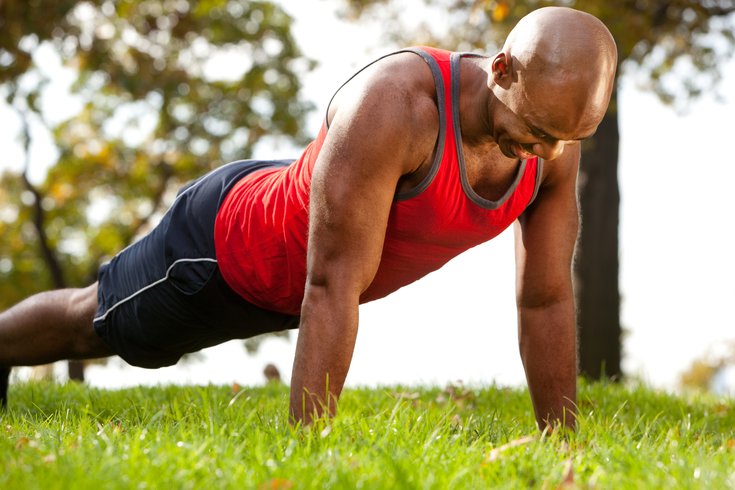
March 01, 2021
 Source/Image licensed from Ingram Image
Source/Image licensed from Ingram Image
To perform a correct pushup, start in a high plank position, with your hands set about shoulder width apart, and lower your body while keeping your back flat. Once you are hovering above the ground, push through your hands and exhale as you push your body back up to the starting position.
There are tons of ways to strengthen your upper body by using all sorts of dumbbells and kettlebells and bands. We know this already. So I'm here to tell you to set those aside and forget about that crazy balancing bicep curl you saw someone at the gym attempting. Instead, focus on your bodyweight.
At Drucker Fitness there are really only two upper body exercises that we focus on, pushups and pull-ups, and all the fun ways we can make them harder for those more advanced. These two exercises are all you need when it comes to the upper body.
Obviously, you can't and shouldn’t rep out 1,000 pushups and pull-ups every workout, so that's where the other upper body exercises come into play. When it comes down to training the upper body, these two exercises should be your main focus. Before you start throwing weights up over your head and pressing them over your face, you should be able to master your own bodyweight. You wouldn't add weights to your squat before you are able to perform it with the correct form, so why would you add weights into your upper body routine before you can push and pull your own bodyweight?
Before we jump to conclusions, I'm not saying you shouldn't touch a dumbbell until you can do a pushup or pull-up. You should definitely use additional weights and various other upper body exercises to help strengthen and train your upper body to the point where your pushups and pull-ups are perfect and easy. However, you shouldn't automatically jump to bench pressing 100 pounds if you can't push your 130-pound body off the ground.
There are two main categories of exercise for the upper body, push exercises and pull exercises. It is important to train both as they work different muscles, resulting in a more balanced upper body. Working both push and pull exercises helps to prevent injuries and avoid overtraining because you are differentiating between muscle groups and movement patterns. By incorporating both pushups and pull-ups into your workouts, you are allowing your body to work both motions. While both exercises hit most of the upper body, let's focus on the main muscle groups working in each exercise.
Pushups target the chest muscles, shoulders, triceps, latissimus dorsi (also known as the bat wings) and — here's the biggest surprise — your abs! To perform the perfect pushup, the core needs to remain engaged, meaning you are not letting your hips sag to the floor or lifting your butt into the air. Rather, your entire posterior chain should remain in one straight line.
To perform a correct pushup, start in a high plank position, with your hands set about shoulder width apart, and lower your body while keeping your back flat. Once you are hovering above the ground, push through your hands and exhale as you push your body back up to the starting position.
Pushups are tough, and easy to do poorly. So if you notice yourself doing more of "the worm" on the way back up, it's time to modify. There is absolutely nothing wrong with modifying the exercise to perform it better; you will get so much more out of doing a modified pushup than one with your hips sagging to the ground. I refuse to use the term "girl pushup" because both men and women struggle with pushups, so remove that term from your vocabulary.
There are a few ways to modify your pushup. My favorite method is to use a squat rack. Raise the bar to a height that you feel you can perform a pushup with the correct form. Then, place your hands on the bar instead of the ground to perform an elevated pushup. The lower to the ground that you set the bar, the harder the exercise will be to perform.
I like this method the most because you are still training your body to go the full range of motion. If you don't have access to a squat rack, a couch or chair also will work. Another option is to drop down to your knees for the pushup, similar to the standard pushup. Make sure to keep your core engaged and back flat as you lower to the ground. There are so many exercises that will strengthen your pushups, but a few favorites of mine are planks, tricep dips, commandos, shoulder presses and flyes.
Pull-ups target the latissimus dorsi, trapezius and thoracic erector spinae — these three muscles make up the main muscle groups of the back. Pull-ups also target smaller muscles like the biceps, triceps and chest. Just like with pushups, the core is another large component of performing pull-ups correctly.
When performing the pull-up, you want to keep your core tight. That enables you to keep more tension throughout the entire body, which promotes more stability and prevents injury. Pull-ups are tough and the best advice to be able to do one is to practice, practice, practice. But with that being said, there are a few ways to help train toward this goal.
Negatives are my favorite because, similar to the elevated pushup, you are still performing the full movement with your entire body weight. To perform a negative, set yourself below the bar. Instead of lifting yourself up (as if doing a pull-up), jump up so your head is above the bar and then slowly (count to five) lower yourself down to a straight arm hang. Set your feet back down and then go again. If you're on the shorter side or can't jump very high, I'd suggest grabbing a chair and using that to jump off; slowly, you will find that you need to jump less and can use your arms more for the pull.
Another pull-up modification is using a large resistance band. Tie the band around the bar and then put either your knee, both knees or, if you need the extra help, your foot in the hanging loop. Adding a resistance band will give you some extra help and control.
There are a few different types of pull-ups depending on your grip. Though one might feel easier than another, it's important to mix them all into your workouts because they work slightly different muscles.
Chin-ups, in which your palms are facing you, are typically the easiest to master because they recruit the biceps the most, whereas neutral grip pull-ups, with your palms facing each other, and standard pull-ups, with your palms facing away from you, are a bit tougher to do.
As with pushups, there are tons of exercises you can do to strengthen the main muscles used in pull-ups. All variations of rows are great to strengthen the back muscles, such as wide grip rows, narrow arm rows, renegade rows and single-arm-bent-over rows.
Lat pulldowns are great as well, but without a gym those are tough to perform. So I like to instead incorporate prone shoulder retractions into my workouts. To perform this exercise, lie on your stomach and grab a lighter set of dumbbells. Start with your arms straight out in front of you. Then drive your elbows down into your rib cage. Each time you do so lift your chest up off the ground and squeeze your elbows into your back. Then extend your arms back out in front of you and relax them onto the ground. These are great for strengthening your lower back as well as your lats.
Small accessory upper body movements, like bicep curls and shoulder raises, are great to train the muscles when you have time for a long, full workout. But don't stress when that can't always happen. Between pushups and pull-ups, you are covering the entire upper body and different planes of motion.
So the next time you're short on time in the gym, there's no need to worry about fitting in an entire upper body workout. Rep out pushups and pull-ups and your arms will be fried. The best part is the only piece of equipment you need is a pull-up bar, which you can order from Amazon!
Try adding these training exercises into your next workout and get that much closer to perfecting your pushups and pull-ups.